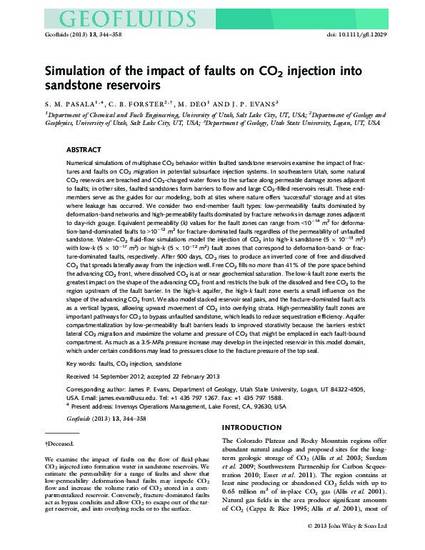
Article
Simulation of the impact of faults on CO2 injection into sandstone reservoirs
Geoflluids
(2012)
Abstract
Numerical simulations of multiphase CO2 behavior within faulted sandstone reservoirs examine the impact of fractures
and faults on CO2 migration in potential subsurface injection systems. In southeastern Utah, some natural
CO2 reservoirs are breached and CO2-charged water flows to the surface along permeable damage zones adjacent
to faults; in other sites, faulted sandstones form barriers to flow and large CO2-filled reservoirs result. These endmembers
serve as the guides for our modeling, both at sites where nature offers ‘successful’ storage and at sites
where leakage has occurred. We consider two end-member fault types: low-permeability faults dominated by
deformation-band networks and high-permeability faults dominated by fracture networks in damage zones adjacent
to clay-rich gouge. Equivalent permeability (k) values for the fault zones can range from <1014 m2 for deformation-
band-dominated faults to >1012 m2 for fracture-dominated faults regardless of the permeability of unfaulted
sandstone. Water–CO2 fluid-flow simulations model the injection of CO2 into high-k sandstone (5 9 1013 m2)
with low-k (5 9 10
17 m2) or high-k (5 9 10
12 m2) fault zones that correspond to deformation-band- or fracture-
dominated faults, respectively. After 500 days, CO2 rises to produce an inverted cone of free and dissolved
CO2 that spreads laterally away from the injection well. Free CO2 fills no more than 41% of the pore space behind
the advancing CO2 front, where dissolved CO2 is at or near geochemical saturation. The low-k fault zone exerts the
greatest impact on the shape of the advancing CO2 front and restricts the bulk of the dissolved and free CO2 to the
region upstream of the fault barrier. In the high-k aquifer, the high-k fault zone exerts a small influence on the
shape of the advancing CO2 front. We also model stacked reservoir seal pairs, and the fracture-dominated fault acts
as a vertical bypass, allowing upward movement of CO2 into overlying strata. High-permeability fault zones are
important pathways for CO2 to bypass unfaulted sandstone, which leads to reduce sequestration efficiency. Aquifer
compartmentalization by low-permeability fault barriers leads to improved storativity because the barriers restrict
lateral CO2 migration and maximize the volume and pressure of CO2 that might be emplaced in each fault-bound
compartment. As much as a 3.5-MPa pressure increase may develop in the injected reservoir in this model domain,
which under certain conditions may lead to pressures close to the fracture pressure of the top seal.
Keywords
- Carbon dioxide,
- sequestration,
- sandstones,
- faults
Disciplines
Publication Date
Spring 2012
DOI
doi: 10.1111/gfl.12029
Citation Information
Sangeetha Pasala, Craig B. Forster, Milind Deo and James P. Evans. "Simulation of the impact of faults on CO2 injection into sandstone reservoirs" Geoflluids Vol. 13 (2012) p. 344 - 358 ISSN: 1468-8123 Available at: http://works.bepress.com/james_evans/113/
Creative Commons license

This work is licensed under a Creative Commons CC_BY International License.
